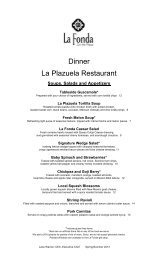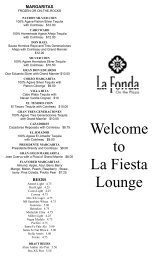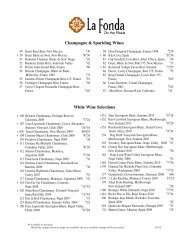in every room a story of the art in every room a ... - La Fonda Hotel
in every room a story of the art in every room a ... - La Fonda Hotel
in every room a story of the art in every room a ... - La Fonda Hotel
Create successful ePaper yourself
Turn your PDF publications into a flip-book with our unique Google optimized e-Paper software.
Harrison Begay graduated<br />
from Dorothy Dunn’s<br />
The Studio School <strong>in</strong> 1939<br />
as salutatorian. Dunn’s goal<br />
was to encourage young<br />
Native Americans to<br />
develop a style based<br />
on <strong>the</strong> students’ native<br />
traditions. Although<br />
Dunn’s approach has s<strong>in</strong>ce<br />
been supplanted, Begay<br />
cont<strong>in</strong>ues to pa<strong>in</strong>t <strong>in</strong><br />
<strong>the</strong> “Studio Style”.<br />
pottery. Hewett asked Maria M<strong>art</strong><strong>in</strong>ez if she could replicate <strong>the</strong> ancient forms.<br />
He asked Julian to recreate <strong>the</strong> pa<strong>in</strong>ted surface designs. Among <strong>the</strong> pieces Hewett<br />
dug up were shards featur<strong>in</strong>g an unusual black-on-black glaze. After much trial<br />
and error, Maria duplicated <strong>the</strong> process <strong>of</strong> mak<strong>in</strong>g <strong>the</strong> pots, and Julian perfected<br />
<strong>the</strong> glossy and matte glazes used to create <strong>the</strong> designs. The rest, as <strong>the</strong>y say,<br />
is hi<strong>story</strong>. The couple’s life-long collaboration made San Ildefonso a center for<br />
Pueblo pottery, and Maria, Julian, and later <strong>the</strong>ir children would comprise <strong>the</strong><br />
most famous Native American pottery-mak<strong>in</strong>g family <strong>in</strong> <strong>the</strong> world.<br />
Romando Vigil’s life began auspiciously on San Ildefonso Pueblo’s feast day.<br />
Vigil (1902–1978) was named Tse-Ye-Mu (“Fall<strong>in</strong>g Cloud”), and was also a selftaught<br />
<strong>art</strong>ist. Hewett’s encouragement brought about <strong>the</strong> development <strong>of</strong> a San<br />
Ildefonso style <strong>of</strong> watercolor pa<strong>in</strong>t<strong>in</strong>g <strong>in</strong> which <strong>the</strong> <strong>art</strong>ists depicted <strong>the</strong>ir people,<br />
<strong>the</strong> animals <strong>the</strong>y hunted, and <strong>the</strong> dances <strong>the</strong>y danced <strong>in</strong> a two-dimensional style<br />
similar to that be<strong>in</strong>g produced by Tomás Vigil at Tesuque. Romando Vigil’s style<br />
<strong>in</strong>cluded realism and abstraction. He was commissioned to create murals for <strong>the</strong><br />
1933 Exposition <strong>of</strong> Indian Tribal Arts at <strong>the</strong> Corcoran Gallery <strong>in</strong> Wash<strong>in</strong>gton,<br />
DC, and for Mesa Verde National Park. <strong>La</strong>ter he was a pa<strong>in</strong>ter for Walt Disney<br />
Studios. Many guest <strong>room</strong>s at <strong>La</strong> <strong>Fonda</strong> conta<strong>in</strong> works by Romando Vigil—<br />
multiples <strong>of</strong> several different images brightly hand colored and typical <strong>of</strong> <strong>the</strong><br />
San Ildefonso style.<br />
50 51<br />
Harrison Begay<br />
“Untitled”<br />
Hand-pr<strong>in</strong>ted Silkscreen<br />
Hand pr<strong>in</strong>ted silkscreens from Tewa Enterprises established <strong>in</strong> Santa Fe <strong>in</strong> 1951 by<br />
Harrison Begay also decorate many <strong>of</strong> <strong>the</strong> guest <strong>room</strong>s. The pr<strong>in</strong>ts, <strong>in</strong> editions <strong>of</strong><br />
2,000, are not considered “orig<strong>in</strong>als,” although <strong>the</strong>y were pr<strong>in</strong>ted by hand <strong>in</strong> <strong>the</strong><br />
subtle colors known to be used by Begay and <strong>the</strong> o<strong>the</strong>r <strong>art</strong>ists at Tewa Enterprises.<br />
Born around 1914 <strong>in</strong> <strong>the</strong> Navajo Nation, Begay is known as Haashké yah Níyá<br />
(“Wander<strong>in</strong>g Boy”), and is recognized as <strong>the</strong> fa<strong>the</strong>r <strong>of</strong> 20th-century Navajo <strong>art</strong>.<br />
His mo<strong>the</strong>r died when he was seven, and he was sent to an Indian board<strong>in</strong>g school,<br />
eventually runn<strong>in</strong>g away to return home to herd sheep and study <strong>art</strong> on his own.





